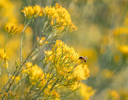Streamside Landscaping
Maintaining a robust buffer of native riparian vegetation is one of the best things you can do to care for your stream. Diversity is key—in plant species types and structural diversity (different layers of vegetation, including trees, shrubs, and ground layers)—to achieve the many environmental benefits of riparian vegetation, as well as a beautiful landscape!
Areas closest to the water’s edge will experience periodic flooding and more of the stresses associated with higher flows. The native riparian shrubs that grow nearest to the water, along with sedges and rushes (grass-like plants) provide stable banks and healthy riparian habitat. Transitioning from the flood-prone areas at the streambank into the upland areas of your property provides many opportunities for more diverse plantings in your landscape.
Plan your riparian area as a “wildscape” to provide habitat for wildlife, both large and small. Multiple layers of vegetation mean more choices of habitat and shelter for mammals, birds, insects, etc. Use native plants whenever possible to provide the preferred food and cover for wildlife and reduce maintenance costs ( see CHOOSING NATIVE PLANTS). As a general rule, once established native plants need less maintenance to thrive because they are adapted to the local conditions, having evolved with the climate, light, and soil types that characterize their local ecosystems. This reduces the need for irrigation, fertilizer and other yard care chemicals.
When it comes to riparian buffers, size matters. Scientific studies recommend a minimum 100-foot buffer of riparian vegetation to protect water quality, as well as fish and aquatic habitat. To protect wildlife and wildlife habitat a minimum 300-foot buffer is recommended, although certain species (many birds and larger mammals) require larger buffers. Of course, 100-300 feet may not be practical or even possible in many urban landscapes. Smaller buffers, in the 50-100 foot range can help protect certain aspects of water quality and offer considerable habitat benefits to many wildlife species. Whenever possible aim to meet the minimums and remember, bigger is always better!










